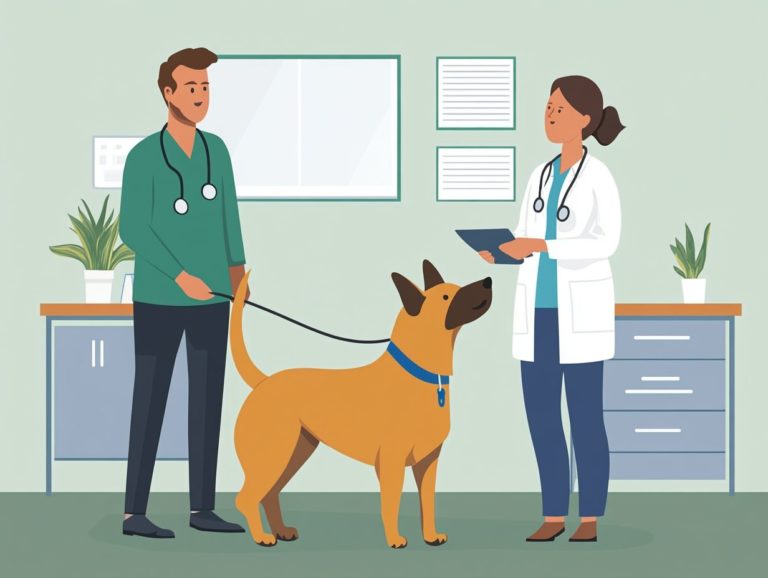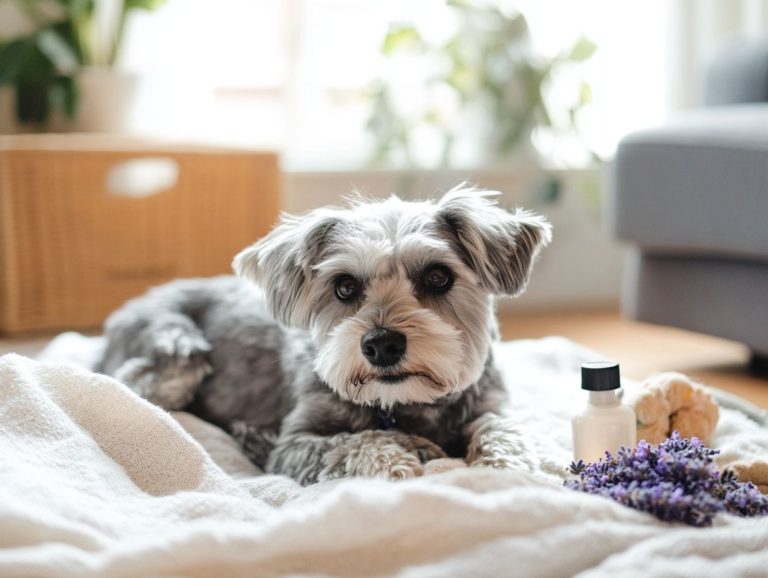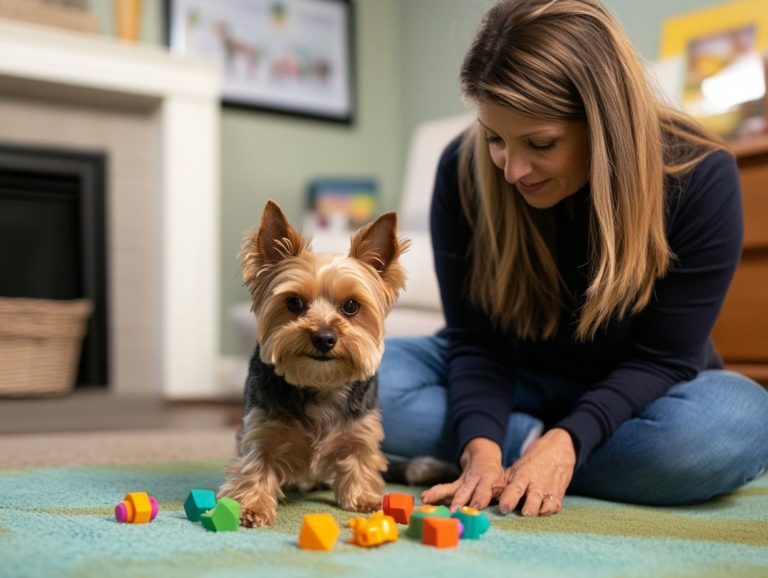How to Help a Rescue Pet with Anxiety
Bringing an adopted dog into your home can be an incredibly heartwarming experience. However, it often presents unique challenges, especially concerning separation anxiety.
Many rescue animals have faced stressful situations that leave lasting emotional scars. It’s crucial to understand the causes and triggers of their anxiety to provide the care they truly deserve.
This article delves into the signs and symptoms of anxiety in rescue pets. It offers effective strategies to help address their fears and create a comfortable space.
It also highlights when to seek professional assistance and outlines ways to ensure your furry companion enjoys lasting mental well-being.
Let s dive in and explore the best tools to help your rescue pet thrive, including techniques for stress reduction.
Contents
- Key Takeaways:
- Understanding Rescue Pet Anxiety
- Signs and Symptoms of Anxiety in Rescue Pets
- Addressing Rescue Pet Anxiety
- Creating a Safe and Comfortable Environment
- Seeking Professional Help
- Supporting Your Rescue Pet’s Mental Health
- Frequently Asked Questions
- What is the best way to help a rescue pet with anxiety?
- What are some signs that my rescue pet may be experiencing anxiety?
- Can I use medication to help my rescue pet with anxiety?
- How can I create a comfortable environment for my rescue pet?
- Is it important to establish a routine for my rescue pet with anxiety?
- What should I do if my rescue pet has a severe anxiety attack?
Key Takeaways:
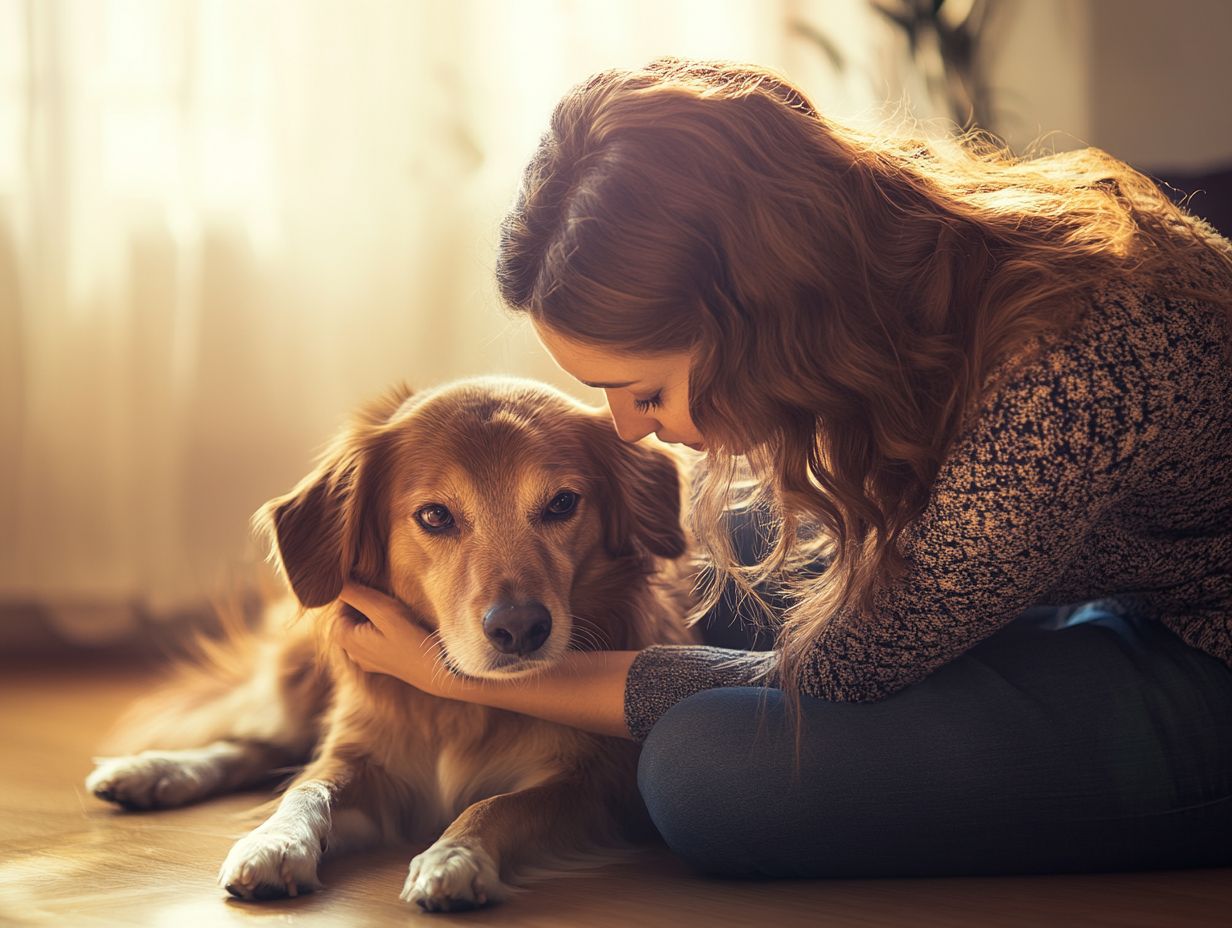
- Recognize the signs and symptoms of anxious behavior in rescue pets to better understand their needs.
- Create a safe and comfortable environment for your rescue pet to help them feel secure and relaxed.
- Seek professional help when needed, such as consulting a veterinarian or animal behaviorist for effective strategies and long-term care for your rescue pet’s anxiety.
Understanding Rescue Pet Anxiety
Understanding rescue pet anxiety is essential for ensuring the well-being of adopted dogs as they navigate their transition into a new home. Many of these animals may carry the emotional weight of past negative experiences in shelters or kennels. To help them adjust, it’s important to know how to support your anxious pet after training, as this can manifest as separation anxiety and various behavioral challenges.
By recognizing the signs of anxiety and employing effective strategies, you can significantly support their adjustment. This will enhance their overall mental health.
It s vital to create a safe space that fosters security. This allows them to gradually acclimate to their new environment at their own pace.
Causes and Triggers
Various factors contribute to separation anxiety in rescue pets, especially adopted dogs transitioning from a kennel or shelter environment.
Previous traumatic experiences, such as neglect or abuse, can leave lasting emotional scars. When these pets find themselves in a new home, the sudden change can intensify their anxiety.
Environmental factors, such as unfamiliar surroundings and new family dynamics, may further heighten their stress levels. Some dogs may protect their food because of past experiences where they had to fight for food or safety.
Understanding how these elements influence a dog s mental well-being is essential for helping them adapt and flourish in their new environment.
Signs and Symptoms of Anxiety in Rescue Pets
Recognizing the signs and symptoms of anxiety in rescue pets, particularly adopted dogs, is crucial for addressing their emotional distress. Learning how to use crate training for anxious pets can be a valuable part of this process.
Look out for common indicators of anxious behavior, such as excessive barking, pacing, or hiding. These can signal that the dog feels overwhelmed in their new surroundings.
Pay attention to physical symptoms like panting, trembling, and changes in appetite. These can offer crucial insights into their mental health status and help you provide the support they need.
Recognizing Behavioral and Physical Indicators
Recognizing the behavioral and physical indicators of anxiety in adopted dogs empowers you to implement effective stress reduction strategies. Your dog may show anxious behaviors like excessive grooming, barking, or withdrawal as they adjust to their new environment.
These signs may appear as pacing, a lowered tail, or even a refusal to eat. It s important to be observant and responsive. Physical signs like trembling, panting, or dilated pupils can indicate heightened stress levels. By staying attuned to these cues, you can address anxiety early and prevent it from escalating.
Using techniques such as creating a safe space, engaging in regular exercise, and practicing calming methods like gentle massage or interactive play can significantly relieve anxiety. By promptly addressing these symptoms, you contribute to a harmonious environment, enhancing both your dog’s well-being and your bond.
Addressing Rescue Pet Anxiety

Effectively addressing rescue pet anxiety requires a blend of calming techniques and structured training programs tailored to the unique needs of your adopted dog. To help you further, it’s important to learn how to identify if your pet has anxiety.
By using positive reinforcement, which means rewarding good behavior, you can shape desired behaviors and help reduce anxious tendencies. Engaging in training programs that involve gradual desensitization, or slowly getting your dog used to new things, fosters a sense of security and comfort in their new environment, paving the way for a smoother transition.
Effective Strategies and Techniques
Effective strategies for managing anxiety in adopted dogs include calming methods, a consistent training program, and ensuring they receive ample exercise and mental stimulation.
Creating a safe and structured environment is essential to reduce the stress that many rescue pets experience. One effective approach is to use KONG toys stuffed with treats to keep your dog engaged and mentally stimulated.
Incorporating daily walks or playtime into their routine can significantly reduce anxiety. Exercise not only tires them out but also offers vital social interactions.
You can employ calming techniques like playing gentle music or using essential oils known for their relaxing properties to create a soothing atmosphere. This way, your furry companion will feel secure and comfortable in their new home.
Creating a Safe and Comfortable Environment
Let s make your dog s new home a cozy haven! Creating a safe and comfortable environment is essential for helping adopted dogs settle in and truly feel secure. Establishing a designated safe space allows them to retreat during stressful moments, significantly enhancing their mental well-being.
This area should be quiet and cozy, thoughtfully equipped with orthopedic dog beds and familiar items to ease their transition.
Designing a Space for Relaxation and Security
Designing a space for relaxation and security is crucial for adopted dogs, as it aids their settling-in process and reduces stress. Create a comfortable area that includes familiar scents and items to help them feel at ease.
Consider crafting a cozy nook with plush bedding, blankets, and toys to replicate the warmth of their previous surroundings. This thoughtful touch provides reassurance and eases their transition. Incorporating elements like soft lighting and calming colors will enhance the ambiance, making the space inviting.
Establishing a designated safe area, free from sudden noises and disturbances, can greatly alleviate anxiety during this crucial period. To support their emotional well-being, think about using environmental design strategies like soundproofing spaces or using natural barriers like shrubs to shield them from overwhelming stimuli.
These carefully considered details play a vital role in fostering a nurturing environment where rescue pets can thrive and gradually feel at home.
Seeking Professional Help
Seeking professional help is essential when addressing severe anxiety issues in adopted dogs. This is especially true if symptoms linger despite your best home interventions. Consulting a veterinarian or an animal behaviorist a specialist in how animals behave can offer valuable insights and tailored training programs that meet your dogs’ unique needs.
This expertise can greatly help you in your journey toward helping your furry friend find comfort and confidence.
When to Consult a Veterinarian or Animal Behaviorist

Knowing when to consult a veterinarian or animal behaviorist can make a world of difference in managing behavioral issues and emotional distress in adopted dogs.
It’s crucial to recognize the signs that signal a need for professional help for the well-being of your pet. Stay vigilant for symptoms like severe anxiety. These may show up as excessive barking, trembling, or hiding.
Persistent behavioral challenges such as aggression, destructive habits, or fear-based reactions can disrupt daily life. You should also be attentive to signs of emotional distress, like changes in appetite, lethargy, or withdrawal from family interactions.
By understanding these indicators, you can ensure your dog receives the appropriate support they need. This paves the way for a happier, healthier life.
Supporting Your Rescue Pet’s Mental Health
Supporting your rescue pet’s mental health is an exciting journey that requires care and commitment. It demands a genuine commitment to long-term care and effective strategies that foster emotional well-being.
By integrating regular exercise and mental stimulation into their daily routine, you can greatly enhance the quality of life for your adopted dog. This enables them to adjust and truly thrive in their new home.
Long-term Care and Maintenance Strategies for Separation Anxiety
Long-term care and maintenance strategies for your adopted dog are crucial in reducing stress and enhancing mental well-being. Establishing a consistent routine that incorporates regular exercise and mental stimulation can significantly alleviate anxiety over time.
Incorporating daily walks, playful runs, or engaging activities allows your rescue pet to release pent-up energy and fosters a stronger bond between you. Mental challenges such as puzzle toys, KONG toys, training sessions, or a structured training program not only keep their minds sharp but also boost their confidence.
Create a routine that balances physical activity with mental engagement. This will help cultivate a stable environment where your dog feels safe and secure in their comfortable space.
This ultimately contributes to a happier and more fulfilling life for your furry companion. These strategies are essential for addressing the unique needs of adopted dogs, promoting their overall health and emotional stability, particularly in managing behavioral issues that may arise in a new kennel environment.
Watch this helpful video for more insights.
Frequently Asked Questions
What is the best way to help a rescue pet with anxiety?
The best way to help a rescue pet with anxiety is to provide a safe and comfortable environment, establish a consistent routine, and give them plenty of love and attention while utilizing calming techniques and positive reinforcement.
What are some signs that my rescue pet may be experiencing anxiety?
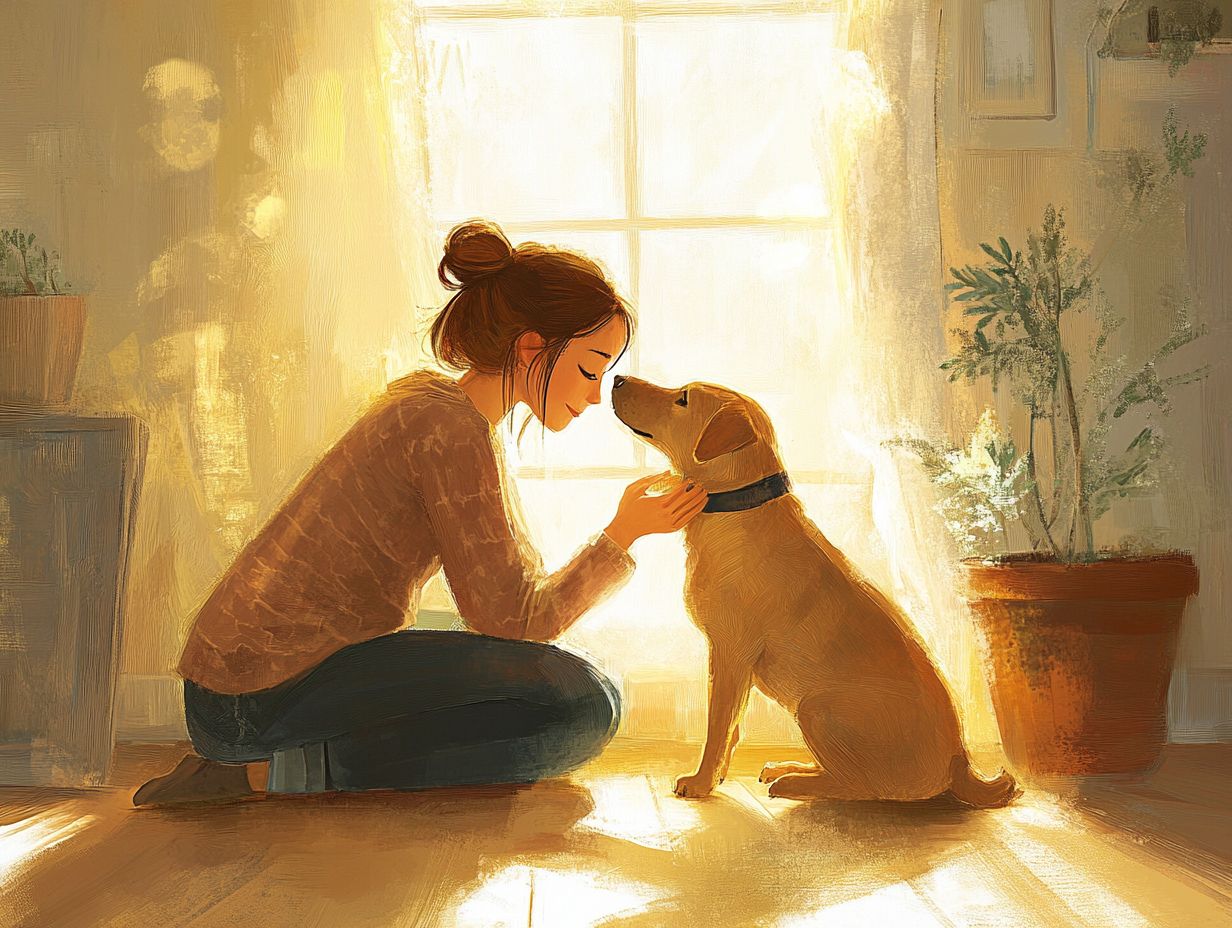
Signs of anxiety in a rescue pet may include excessive barking or meowing, destructive behavior, aggression, pacing, anxious behavior, and hiding or trying to escape, especially in unfamiliar situations. If you notice these signs worsening, it’s important to know what to do if your pet’s anxiety worsens.
Can I use medication to help my rescue pet with anxiety?
Medication should only be used as a last resort and under the guidance of a veterinarian. There are many other effective ways to help a rescue pet with anxiety, such as exercise, training, and tips for training anxious pets at home, as well as natural remedies like Earthbath Stress Relief Shampoo or Thundershirts.
How can I create a comfortable environment for my rescue pet?
To create a comfortable environment for your rescue pet, make sure they have a designated safe space. Providing them with toys and activities like puzzle toys or KONG toys can help, along with using calming scents such as lavender or chamomile. For more strategies, check out helpful tips for reducing pet anxiety.
Is it important to establish a routine for my rescue pet with anxiety?
Yes! Establishing a routine can greatly reduce anxiety in rescue pets. It provides the structure and predictability they need, especially if they’re experiencing emotional distress.
Include regular feeding times, exercise, and playtime in their daily schedule. This will help your pet feel secure and relaxed.
What should I do if my rescue pet has a severe anxiety attack?
If your rescue pet has a severe anxiety attack, stay calm and remove them from the trigger. Additionally, learn how to recognize and address anxiety in pets by creating a quiet and safe space for them.
Distract them with toys or treats. If the anxiety continues, consider consulting an expert who specializes in helping pets with behavior issues.


